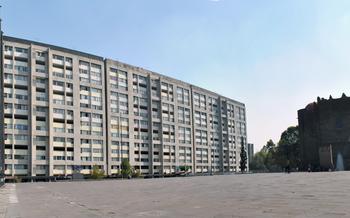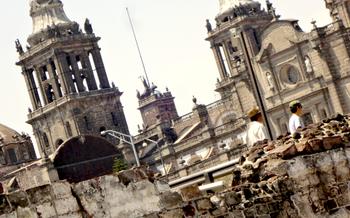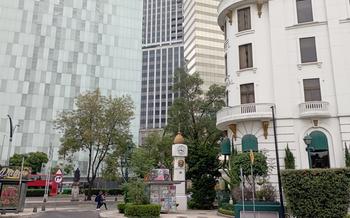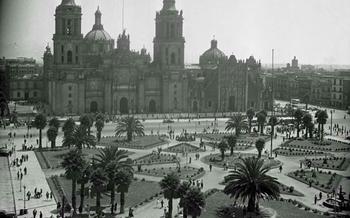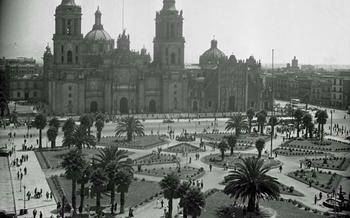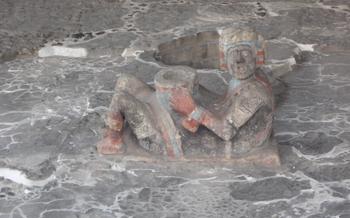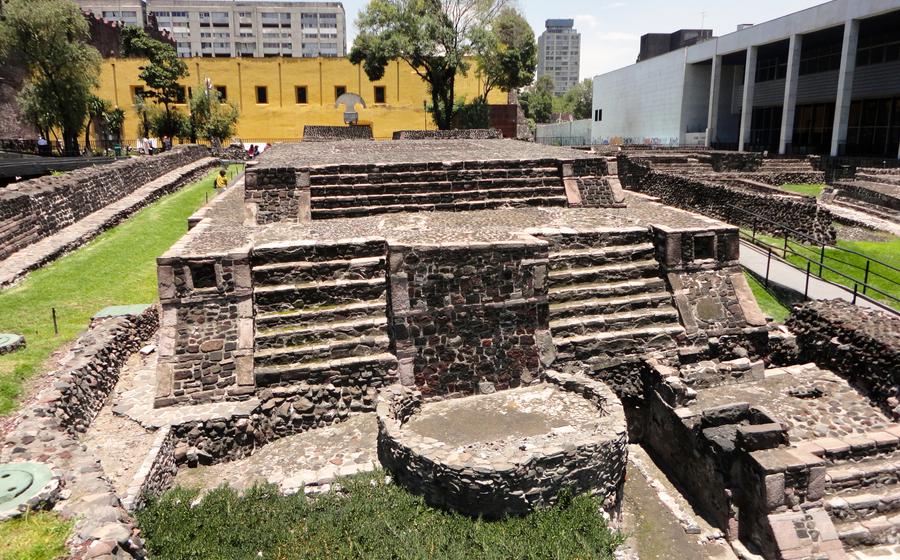
Tlatelolco Archaeological Site
- A Monument to the Past: Discovering Tlatelolco's Ancient Ruins
- Tlatelolco's Archaeological Significance: A Glimpse into Pre-Columbian Civilizations
- The Templo Mayor: A Sacred Center of Aztec Worship and Power
- Excavating the Past: Unearthing Artifacts and Secrets at Tlatelolco
- Plaza de las Tres Culturas: A Fusion of History and Modernity
- Museo de Sitio de Tlatelolco: A Window into the Past
- Interactive Museum Experiences: Bringing History to Life
- The Market of Tlatelolco: A Vibrant Tapestry of Culture and Commerce
- Tlatelolco's Murals: Expressions of History and Resistance
- The Church of Santiago Tlatelolco: A Colonial Gem
- Practical Tips for Visiting Tlatelolco: Ensuring a Smooth Experience
- Suggested Itineraries for Exploring Tlatelolco: Maximizing Your Time
- Insider Tip: Unveiling Hidden Gems
A Monument to the Past: Discovering Tlatelolco's Ancient Ruins
In the heart of Mexico City, nestled amidst the bustling streets and towering skyscrapers, lies a hidden gem that transports visitors to a bygone era. The Tlatelolco Archaeological Site, a vestige of Mexico's rich pre-Columbian past, stands as a testament to the ingenuity and grandeur of ancient civilizations. Its origins can be traced back to the 14th century when it served as a thriving city-state within the Aztec Empire. Tlatelolco's significance extends beyond its historical importance, as it offers a glimpse into the daily lives, beliefs, and cultural practices of the ancient Aztecs.
As visitors explore the site, they will encounter a captivating array of architectural marvels that speak to the artistry and engineering prowess of the Aztec civilization. The Templo Mayor, an awe-inspiring twin pyramid dedicated to the gods Huitzilopochtli and Tlaloc, dominates the landscape. Its intricate carvings and imposing presence evoke a sense of reverence and wonder. Numerous other temples, shrines, and residential structures surround the Templo Mayor, providing insights into the urban layout and social organization of ancient Tlatelolco.
The site's archaeological significance is further enriched by the numerous artifacts unearthed during excavations. These relics, ranging from pottery and sculptures to jewelry and tools, offer valuable clues about the economic activities, social structures, and cultural traditions of the Aztec people. The discoveries at Tlatelolco have played a crucial role in shedding light on the lives of this ancient civilization, helping us to understand their beliefs, customs, and contributions to Mesoamerican history.
Beyond its historical and archaeological importance, Tlatelolco offers a unique cultural experience that blends the allure of the past with the dynamism of modern Mexico City. The site's proximity to contemporary buildings and bustling markets creates a fascinating juxtaposition that highlights the city's rich tapestry of history and modernity. Visitors can easily transition from exploring ancient ruins to immersing themselves in the vibrant atmosphere of Mexico's capital, creating a truly unforgettable experience.
Tlatelolco's Archaeological Significance: A Glimpse into Pre-Columbian Civilizations
As one of the most important city-states in the Aztec Empire, Tlatelolco played a pivotal role in shaping the history and culture of ancient Mexico. Its strategic location and vibrant marketplace made it a center of commerce and cultural exchange, attracting people from all corners of the empire. Despite suffering significant destruction during the Spanish conquest, Tlatelolco's enduring legacy is evident in its impressive archaeological remains.
Tlatelolco's resilience is a testament to the ingenuity and adaptability of its inhabitants. After the conquest, the site transformed into a vibrant neighborhood, blending its pre-Columbian roots with colonial influences. This unique fusion is reflected in the architectural styles of its buildings, seamlessly integrating ancient pyramids with Spanish colonial churches. The presence of Mesoamerican influences in Tlatelolco's architecture and cultural practices highlights the enduring impact of pre-Columbian civilizations on Mexican society.
Exploring Tlatelolco is a journey through time, offering a glimpse into the lives and achievements of ancient Mexican civilizations. It stands as a symbol of cultural resilience, showcasing the harmonious coexistence of diverse historical influences that have shaped Mexico's rich and multifaceted identity.
The Templo Mayor: A Sacred Center of Aztec Worship and Power
At the that once served as the sacred center of Aztec worship and power. This awe-inspiring complex, consisting of twin pyramids dedicated to the gods Huitzilopochtli and Tlaloc, stands as a testament to the ingenuity and grandeur of the Aztec civilization.
The Templo Mayor was not merely a place of worship; it was the embodiment of Aztec religious beliefs and the epicenter of their political and ritual life. Here, the Aztecs performed elaborate ceremonies, offered sacrifices, and celebrated festivals honoring their deities. The temple's towering presence symbolized the power and influence of the Aztec Empire, serving as a reminder of their dominance over the region.
Excavations at the Templo Mayor have unearthed a wealth of artifacts, providing valuable insights into Aztec beliefs and practices. From intricate sculptures and jewelry to sacrificial offerings, these discoveries have shed light on the religious rituals and daily life of the Aztec people. The ongoing archaeological work at the site continues to reveal new secrets, offering a glimpse into the vibrant and complex world of this ancient civilization.
Excavating the Past: Unearthing Artifacts and Secrets at Tlatelolco
Tlatelolco's archaeological excavations have been instrumental in revealing the rich history and intricate details of ancient life in the city. Over the years, archaeologists have painstakingly unearthed a plethora of artifacts that provide valuable insights into the daily activities, economic systems, social structures, and cultural traditions of the ancient inhabitants. These discoveries have shed light on the intricate pottery-making techniques, the sophisticated jewelry designs, and the diverse range of tools utilized by the ancient artisans and craftsmen of Tlatelolco.
The artifacts unearthed at Tlatelolco offer a glimpse into the vibrant and complex society that once thrived within its walls. From ornate sculptures depicting deities and mythical creatures to intricate ceramic vessels used for everyday purposes, each artifact tells a story of the people who lived and worked in this ancient metropolis. Through careful study and analysis, archaeologists have pieced together a comprehensive picture of Tlatelolco's past, showcasing the ingenuity, creativity, and resilience of its inhabitants.
Preserving these artifacts is of paramount importance, as they serve as tangible links to the past and provide invaluable insights into the cultural heritage of Mexico. Museums and institutions play a crucial role in safeguarding and studying these artifacts, ensuring that they are properly cataloged, stored, and made accessible to researchers and the general public. By preserving these relics of the past, we honor the legacy of Tlatelolco and ensure that its rich history continues to inspire and educate future generations.
Plaza de las Tres Culturas: A Fusion of History and Modernity
The Plaza de las Tres Culturas stands as a testament to Tlatelolco's rich and multifaceted history, harmoniously blending the remnants of its pre-Columbian past with colonial architecture and modern structures. This unique plaza serves as a stage for understanding Mexico's complex historical narrative, where ancient ruins coexist with contemporary buildings, creating a fascinating interplay of eras.
The plaza's name, meaning "Plaza of the Three Cultures," aptly reflects its role as a meeting ground of civilizations. Here, visitors can admire the Templo Mayor, a sacred Aztec site, alongside the colonial-era Church of Santiago Tlatelolco and the modern Conjunto Urbano Tlatelolco, a housing complex built in the 1960s. This architectural diversity symbolizes the fusion of cultures that has shaped Mexico's identity.
The plaza has witnessed pivotal moments in Mexico's history, serving as a gathering place for both joyous celebrations and tragic events. It was here that the Aztec emperor Cuauhtémoc surrendered to the Spanish conquistadors, marking the end of the Aztec Empire. Centuries later, the plaza became the site of the infamous Tlatelolco Massacre in 1968, where government forces opened fire on student protesters, leaving hundreds dead.
Despite its tragic past, the Plaza de las Tres Culturas remains a vibrant and dynamic space, embodying Mexico's resilience and its ability to embrace both its ancient roots and its modern aspirations. Today, the plaza is a popular gathering spot for locals and tourists alike, who come to admire its architectural wonders, stroll through its gardens, and soak in the atmosphere of this unique urban oasis.
Museo de Sitio de Tlatelolco: A Window into the Past
The Museo de Sitio de Tlatelolco is an essential destination for those seeking a deeper understanding of the site's rich history and significance. Through its curated exhibits, visitors embark on a journey through time, exploring the various cultures and civilizations that have shaped Tlatelolco. Artifacts, interactive displays, and multimedia presentations bring the past to life, providing insights into the daily lives, beliefs, and traditions of the ancient inhabitants.
The museum's collection includes a vast array of archaeological treasures, from pottery and sculptures to jewelry and tools. These artifacts offer a glimpse into the economic activities, social structures, and cultural practices of the people who once called Tlatelolco home. The museum also delves into the site's more recent history, addressing the tragic events of the 1968 Tlatelolco Massacre and its impact on Mexican society.
By visiting the Museo de Sitio de Tlatelolco, visitors gain a comprehensive understanding of the site's multifaceted history and cultural significance. The museum serves as a valuable resource for researchers, students, and history enthusiasts, providing a deeper context for their exploration of Tlatelolco. Whether you're a first-time visitor or a seasoned traveler, the museum offers a captivating and educational experience that enhances your appreciation for this remarkable site.
Interactive Museum Experiences: Bringing History to Life
The Museo de Sitio de Tlatelolco offers a range of interactive exhibits that bring the site's history and culture to life. Visitors can engage with hands-on displays, multimedia presentations, and augmented reality experiences that enhance their understanding of the site.
Interactive displays allow visitors to explore artifacts, manipulate models, and participate in simulations. These hands-on experiences provide a deeper level of engagement and help visitors connect with the past in a more personal way.
Multimedia presentations use audio-visual technology to immerse visitors in the site's history and culture. These presentations may include documentaries, historical reenactments, and virtual tours that bring the past to life.
Augmented reality experiences overlay digital information onto the real world, creating an immersive and interactive learning environment. Visitors can use augmented reality apps to view 3D models of ancient structures, explore archaeological excavations, and interact with virtual characters from the past.
These interactive experiences not only enhance the visitor's understanding of Tlatelolco's history but also make learning fun and engaging. They are a valuable tool for educators and a great way for visitors of all ages to connect with the past.
The Market of Tlatelolco: A Vibrant Tapestry of Culture and Commerce
Amidst the historical wonders of Tlatelolco, the vibrant market stands as a testament to the site's enduring vitality. A bustling hub of activity, the market is a kaleidoscope of colors, sounds, and aromas, where locals and tourists alike come together to experience the essence of Mexican culture and commerce.
Strolling through the market's labyrinthine alleys, visitors are greeted by a cacophony of voices, the laughter of children, and the enticing calls of vendors promoting their wares. Every corner reveals a treasure trove of handmade crafts, from intricate textiles and colorful pottery to traditional toys and souvenirs. The stalls overflow with an array of traditional Mexican garments, woven with vibrant threads and adorned with intricate embroidery.
In addition to handicrafts, the market is renowned for its culinary delights. The air is filled with the mouthwatering aromas of sizzling tacos, freshly grilled corn, and sweet churros. Vendors tempt passersby with an array of regional specialties, from steaming bowls of pozole to crispy tlayudas topped with cheese and beans.
The Market of Tlatelolco is not just a place of commerce but also a place of cultural exchange and community. Locals gather to share stories, gossip, and laughter, while tourists immerse themselves in the lively atmosphere and vibrant traditions. The market is a microcosm of Mexican society, where the past and present intertwine, creating a unique and unforgettable experience.
Tlatelolco's Murals: Expressions of History and Resistance
The walls of Tlatelolco are adorned with stunning murals, each a powerful expression of history, resistance, and social struggles. These artistic masterpieces depict key events from Mexico's past, such as the Spanish conquest, the Mexican Revolution, and the student-led protests of 196
Through their vibrant colors and evocative imagery, the murals convey powerful messages about social injustice, political oppression, and the fight for freedom. They serve as a reminder of the struggles that the Mexican people have endured throughout history and their ongoing pursuit of social justice.
One of the most iconic murals is the "History of Mexico" by David Alfaro Siqueiros, which spans the entire length of a building in the Plaza de las Tres Culturas. The mural depicts key moments in Mexican history, from the pre-Columbian era to the Mexican Revolution.
Another notable mural is the "Tlatelolco Massacre" by José Luis Cuevas, which portrays the tragic events of 1968 when government forces opened fire on student protesters in the Plaza de las Tres Culturas. The mural is a powerful indictment of state violence and a reminder of the ongoing struggle for human rights in Mexico.
These murals are not just works of art; they are powerful symbols of resistance and social change. They serve as a reminder of the importance of fighting for justice and equality, and they continue to inspire new generations of activists and artists in Mexico and beyond.
The Church of Santiago Tlatelolco: A Colonial Gem
Amidst the bustling streets of Tlatelolco, stands the magnificent Church of Santiago Tlatelolco, a testament to the region's rich colonial past. Constructed in the 16th century, the church boasts a harmonious blend of Gothic and Renaissance architectural styles, showcasing intricate carvings, majestic arches, and a stunning facade that captivates visitors. Its historical significance lies in its role as a pivotal site in the evangelization of Mexico. The church's survival through various historical events, including the tumultuous Spanish conquest, speaks to its enduring strength and resilience. Step inside to explore the church's awe-inspiring interior, adorned with intricate altarpieces, elaborate paintings, and finely crafted sculptures that narrate the story of Mexico's colonial heritage. The Church of Santiago Tlatelolco stands as a symbol of Tlatelolco's enduring spirit, a reminder of its pivotal role in shaping Mexico's cultural and religious identity.
Practical Tips for Visiting Tlatelolco: Ensuring a Smooth Experience
Planning Your Visit: - Aim to arrive early in the morning or late afternoon to avoid the midday heat and crowds. - Guided tours are available in English and Spanish, providing valuable insights and historical context. - Check the Tlatelolco Archaeological Site website for updated information on hours of operation and any special events. - Consider purchasing a Mexico City Pass for discounted admission to multiple attractions, including the Tlatelolco site.
Dress Code and Precautions: - Dress comfortably and appropriately for the weather, as the site involves a lot of walking and exposure to the sun. - Wear comfortable shoes suitable for uneven terrain. - Remain vigilant and aware of your surroundings, especially when handling valuables or taking photographs.
Photography and Permits: - Photography is generally permitted for personal use, but using a tripod or flash photography may require a special permit. - Contact the site authorities in advance if you plan to film or conduct professional photography within the archaeological zone.
Accessibility: - The site is wheelchair accessible, with ramps and elevators providing access to most areas. - Accessible restrooms are available near the main entrance. - Consider bringing a portable chair or cushion for resting during your exploration.
Suggested Itineraries for Exploring Tlatelolco: Maximizing Your Time
Half-day Itinerary:
- Morning:
-
Begin your journey with a visit to the Tlatelolco Archaeological Site, immersing yourself in the ancient ruins and unlocking the secrets of the past.
-
Afternoon:
-
Explore the Plaza de las Tres Culturas, marveling at the harmonious blend of pre-Columbian, colonial, and modern architecture.
-
Evening:
- Take a leisurely stroll through the bustling Market of Tlatelolco, savoring the vibrant atmosphere, local crafts, and delicious street food.
Full-day Itinerary:
- Morning:
-
Start your day with a comprehensive tour of the Tlatelolco Archaeological Site, delving into the history, culture, and significance of this ancient metropolis.
-
Afternoon:
-
Visit the Museo de Sitio de Tlatelolco, exploring the curated exhibits and gaining insights into the site's past through interactive displays.
-
Evening:
- Attend a cultural event or performance at the Cultural Center of Tlatelolco, immersing yourself in the vibrant arts scene and engaging with the local community.
Multi-day Itinerary:
- Day 1:
-
Explore the Tlatelolco Archaeological Site and the Templo Mayor, unraveling the mysteries of ancient civilizations and their religious practices.
-
Day 2:
-
Immerse yourself in the vibrant culture of Tlatelolco by visiting the Plaza de las Tres Culturas, the Market of Tlatelolco, and the Church of Santiago Tlatelolco.
-
Day 3:
- Venture beyond Tlatelolco to discover nearby museums and cultural centers, such as the National Museum of Anthropology and the Frida Kahlo Museum.
Insider Tip: Unveiling Hidden Gems
Beyond the well-known attractions, Tlatelolco holds hidden gems waiting to be discovered. Venture off the beaten path to uncover secret spots that offer a unique perspective on the site. Engage with locals to uncover authentic dining experiences and hidden cultural gems. Immerse yourself in the vibrant atmosphere of nearby neighborhoods and markets, gaining insights into everyday Mexican life. These insider tips will transform your visit into an unforgettable journey, allowing you to experience Tlatelolco's rich tapestry of history, culture, and local charm.
